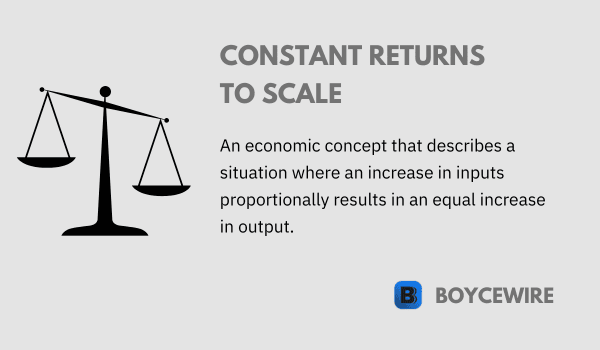Constant Returns to Scale: Assumptions, Effects & Examples

What are Constant Returns to Scale?
Constant returns to scale, as the name suggests, describes a situation where a proportional increase in all inputs leads to an equivalent proportional increase in output. In other words, if a firm doubles all its inputs under the assumption of CRS, its output should also double.
Understanding constant returns to scale is essential as it provides insights into the relationship between input and output, cost structures, and efficiency in the production process. Furthermore, CRS has profound implications for firms’ strategic decisions, market structures, and overall economic performance.
Key Points
- Constant Returns to Scale (CRS) implies that if inputs such as labor and capital are increased by a certain percentage, outputs will increase by the same percentage.
- CRS indicates that a firm can expand its production without experiencing diminishing returns, maintaining a consistent efficiency level.
- CRS is a concept in economics that helps analyze the long-run behavior of production processes and the scalability of businesses.ass=”styled”>
Understanding Constant Returns to Scale
Constant Returns to Scale (CRS) is a concept in production theory that provides insight into the relationship between changes in input and the resultant changes in output. Under CRS, a proportional change in all inputs results in an equivalent proportional change in output.
- Detailed Explanation of CRS To understand CRS, consider a production process where all inputs are increased by a certain percentage. Under CRS, this would lead to an increase in output by exactly the same percentage. For example, if a firm doubles (i.e., increases by 100%) all its inputs — labor, capital, materials, etc. — the output would also double. Conversely, if all inputs were halved, the output would also be halved.
- Differentiating CRS from Increasing and Decreasing Returns to Scale
Returns to scale can also be increasing or decreasing. Increasing Returns to Scale (IRS) occurs when a proportional increase in all inputs leads to a more than proportional increase in output. This could happen due to factors like specialization, better utilization of fixed costs, or synergies among inputs.
On the other hand, Decreasing Returns to Scale (DRS) is when a proportional increase in all inputs results in a less than proportional increase in output. This might occur due to difficulties in managing larger scale operations or inefficiencies that creep in as a firm grows in size.
Constant Returns to Scale thus lies in the middle of these two concepts, where the output changes exactly in proportion to changes in input. Understanding this distinction helps to illustrate the different ways that changes in scale can impact productivity and efficiency in a production process.
Understanding CRS, and returns to scale more generally, is crucial in economics as it helps us understand the fundamental relationship between inputs and outputs, the nature of cost structures, and the strategic choices firms make in their production processes.
Assumptions of Constant Returns to Scale
The notion of constant returns to scale (CRS) relies on several assumptions. These assumptions help to simplify the analysis of production processes and provide a theoretical framework within which CRS can hold.
- Basic Assumptions in CRS Models
- Perfectly Divisible Inputs and Outputs This assumption implies that both inputs and outputs can be divided into any possible size, even the minutest. In other words, production can be scaled up or down without encountering indivisibilities.
- Homogeneous Production Function CRS assumes a homogeneous production function of degree one. This means that if all inputs are multiplied by a certain factor, output will increase by exactly the same factor, representing the essence of CRS.
- Input and Output Prices Remain Constant The CRS model assumes that input and output prices do not change as scale changes. This assumption eliminates the impact of market dynamics on the input-output relationship.
- The Role of These Assumptions in Production AnalysisThese assumptions are crucial for the theoretical analysis of production under CRS. They allow us to focus purely on the technical relationship between inputs and output, without the interference of factors such as indivisibilities, market dynamics, or price changes. However, it’s important to remember that these are simplifying assumptions. In the real world, some of these conditions might not hold true. For instance, certain inputs (like specialized machinery or managerial capacity) may not be perfectly divisible, or prices may change as a firm increases or decreases its scale of operation.
Nonetheless, the CRS model and its assumptions provide a helpful starting point to understand the fundamental dynamics of production, offering valuable insights into cost structures, efficiency, and the implications of scaling production up or down.
Effects of Constant Returns to Scale
Constant returns to scale (CRS) not only provides a theoretical framework for understanding the relationship between inputs and outputs in a production process, but it also has meaningful implications for cost structures, efficiency, and market structures.
1. How CRS Affects Cost Structures
Under the assumption of CRS, as output expands, cost per unit of output remains constant. This is because when all inputs increase proportionally and output increases at the same rate, average costs don’t change. This has important implications for firms’ pricing strategies and profit margins.
2. Impact on Production Efficiency and Profit Maximization
With CRS, firms can expand or contract their production without experiencing efficiency losses or gains associated with scale. In other words, a firm can increase its scale of operation to meet higher demand without worrying about rising costs per unit, thus preserving profit margins.
3. Implications for Market Structure
CRS plays a significant role in shaping market structures. In industries where CRS is prevalent, one might expect to find a large number of firms of similar size, since there are no inherent advantages or disadvantages to being a larger or smaller firm. This contrasts with industries characterized by increasing returns to scale, where market power tends to be concentrated in a few large firms due to cost advantages at larger scales.
Therefore, the assumption of CRS influences various aspects of economic analysis, from cost structures and efficiency to competition and market structure. Understanding these implications allows firms to make strategic decisions about production and growth, and enables policymakers to predict and manage industry dynamics.
Constant Returns to Scale in the Long Run
Understanding the implications of constant returns to scale (CRS) becomes particularly relevant when analyzing production decisions in the long run. The long run, in economic terms, refers to a period sufficient enough for a firm to vary all its inputs.
- Explaining Long-run Production under CRS In the long run, a firm has the flexibility to adjust all its inputs to find the most efficient and cost-effective combination to produce its goods or services. Under the assumption of CRS, a firm can proportionally increase or decrease all of its inputs without affecting its average cost of production. This offers the firm flexibility in scaling operations up or down depending on the demand for its products, without the concern of increasing or decreasing costs per unit.
- Role of CRS in Long-run Cost Curves In the context of long-run cost curves, CRS is associated with a horizontal long-run average cost (LRAC) curve. This is because, under CRS, average costs remain constant regardless of the level of output. Therefore, as the firm increases output, the LRAC curve does not change, demonstrating that the unit cost of production remains the same irrespective of the scale of production.
This behavior of the LRAC curve under CRS provides important insights for firms planning for long-term growth and for understanding industry dynamics. It means that a firm operating under CRS can freely plan its growth strategy based on demand forecasts, without worrying about scale efficiencies. Moreover, it suggests that industries characterized by CRS are likely to be competitive, with multiple firms of various sizes co-existing, since there are no scale-related barriers to entry or cost advantages for larger firms.
Examples of Constant Returns to Scale
It’s helpful to consider real-world examples to illustrate the concept of constant returns to scale (CRS). While in reality, many industries may not strictly adhere to the CRS assumption due to market dynamics, regulatory environments, and other external factors, some industries come close to demonstrating this behavior.
1. Manufacturing Industries
Certain manufacturing industries may exhibit characteristics of CRS. For instance, consider a bicycle assembly plant. If the plant doubles its inputs (labor, raw materials, and capital equipment), it’s likely that the output (the number of bicycles assembled) would also double. Similarly, if inputs were halved, the output would likely reduce by half as well.
2. Agricultural Industries
Certain types of agriculture may exhibit CRS, particularly where modern farming techniques are employed. For instance, if a farm doubles the amount of all inputs (land, labor, machinery, and seeds), the total crop yield might potentially double, assuming constant environmental conditions and no significant land quality variations.
3. Services Industries
Some service sectors might also demonstrate CRS. For instance, in a call center, doubling the number of operators and the workspace should approximately double the number of calls that can be handled, assuming similar working conditions and customer call patterns.
While these examples provide a general idea, it’s important to note that real-world conditions often involve complexities that may cause departures from the perfect CRS scenario. However, these examples serve to highlight the fundamental principle of CRS – proportional increase in inputs leads to a proportional increase in output.
FAQs
CRS means that if inputs are increased proportionately, outputs will increase by the same proportion, resulting in constant efficiency and productivity.
While CRS implies a proportional increase in inputs and outputs, increasing returns to scale suggest that outputs increase at a higher rate than inputs, indicating economies of scale and potentially higher efficiency.
CRS suggests that businesses can expand their production without experiencing diminishing returns or loss of efficiency, allowing for potential economies of scale and cost savings.
CRS is utilized in economic models to analyze the long-run behavior of production processes, cost functions, and the scalability of industries. It helps assess the impact of input changes on output and cost levels.
About Paul
Paul Boyce is an economics editor with over 10 years experience in the industry. Currently working as a consultant within the financial services sector, Paul is the CEO and chief editor of BoyceWire. He has written publications for FEE, the Mises Institute, and many others.

Further Reading
 Absolute Advantage: Definition & Example - When a nation is more efficient making a good over another, it has an absolute advantage.
Absolute Advantage: Definition & Example - When a nation is more efficient making a good over another, it has an absolute advantage.  Bait and Switch - Bait and switch is a deceptive sales tactic that involves advertising a desirable product or offer to attract customers, only…
Bait and Switch - Bait and switch is a deceptive sales tactic that involves advertising a desirable product or offer to attract customers, only…  Arbitrage - Arbitrage refers to the practice of exploiting price differences in different markets to make risk-free profits.
Arbitrage - Arbitrage refers to the practice of exploiting price differences in different markets to make risk-free profits. 
